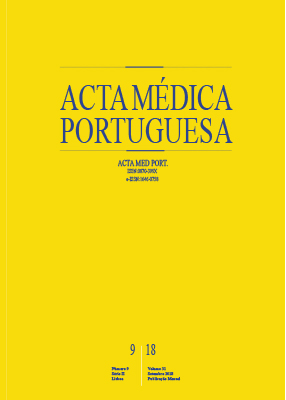Iron Deficiency and Obesity – Are we Diagnosing with Appropriate Indicators?
DOI:
https://doi.org/10.20344/amp.8916Keywords:
Ferritins/deficiency, Iron/deficiency, Metabolic Syndrome, ObesityAbstract
Introduction: We aim to define the iron deficiency prevalence and eventual differences between obese patients with and without metabolic syndrome.
Material and Methods: Analysis of patients evaluated at multidisciplinary consultation of obesity in our institution between 2013 and 2015 (n = 260). Iron deficiency: ferritin levels < 15 ng/mL. Exclusion criteria: prior bariatric surgery; lack of ferritin or hemoglobin determinations.
Results: We analyzed data from 215 patients (84.2% female) with a mean age of 42.0 ± 10.3 years. The median body mass index was 42.5 (40.0 - 46.8) kg/m2 and 52.1% had metabolic syndrome. Iron deficiency was present in 7.0%, with no differences between genders or between patients with or without metabolic syndrome. Hypertension was associated with lower prevalence of iron deficiency. Type 2 diabetes and hypertension patients had higher levels of ferritin. The multivariate analysis showed that metabolic syndrome and increasing body mass index were predictive of higher risk of iron deficiency while hypertension predicted lower odds of iron deficiency.
Discussion: The prevalence of iron deficiency was similar in other published studies. Iron deficiency may be underdiagnosed if based only on ferritin concentrations. In our study, diabetes and hypertension appear to contribute to the increase in ferritin levels described in obesity.
Conclusion: Ferritin may not be a reliable index for evaluating iron stores in obese patients, particularly when associated with comorbidities such as type 2 diabetes and hypertension. Further studies are needed to guide the diagnosis and iron supplementation in these patients.
Downloads
Downloads
Published
How to Cite
Issue
Section
License
All the articles published in the AMP are open access and comply with the requirements of funding agencies or academic institutions. The AMP is governed by the terms of the Creative Commons ‘Attribution – Non-Commercial Use - (CC-BY-NC)’ license, regarding the use by third parties.
It is the author’s responsibility to obtain approval for the reproduction of figures, tables, etc. from other publications.
Upon acceptance of an article for publication, the authors will be asked to complete the ICMJE “Copyright Liability and Copyright Sharing Statement “(http://www.actamedicaportuguesa.com/info/AMP-NormasPublicacao.pdf) and the “Declaration of Potential Conflicts of Interest” (http:// www.icmje.org/conflicts-of-interest). An e-mail will be sent to the corresponding author to acknowledge receipt of the manuscript.
After publication, the authors are authorised to make their articles available in repositories of their institutions of origin, as long as they always mention where they were published and according to the Creative Commons license.









